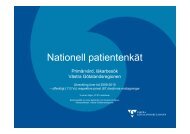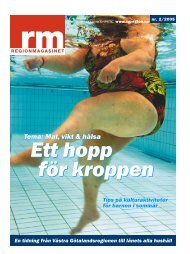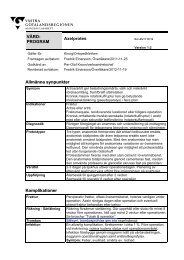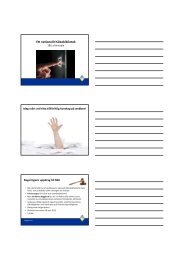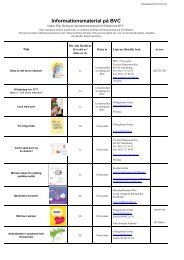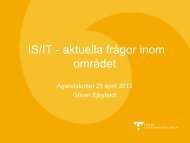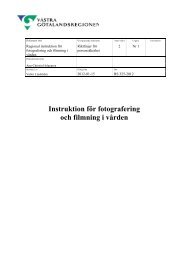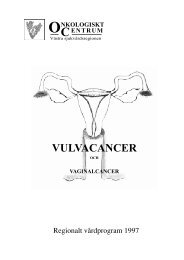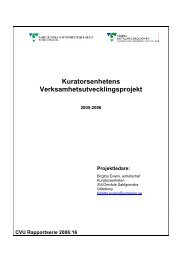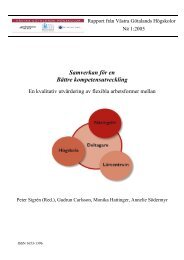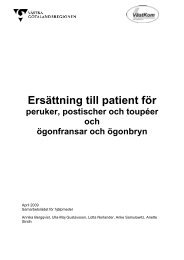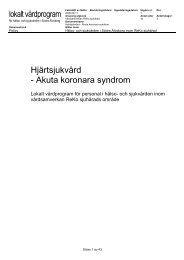Nursing documentation before and after implementation of ...
Nursing documentation before and after implementation of ...
Nursing documentation before and after implementation of ...
You also want an ePaper? Increase the reach of your titles
YUMPU automatically turns print PDFs into web optimized ePapers that Google loves.
Institutionen för vård och natur<br />
<strong>Nursing</strong> <strong>documentation</strong> <strong>before</strong> <strong>and</strong> <strong>after</strong> <strong>implementation</strong> <strong>of</strong><br />
electronic patient records.<br />
Omvårdnadsdokumentationen före och efter implementering av<br />
elektronisk patientjournal.<br />
Examensarbete i omvårdnad, D-nivå<br />
10 poäng<br />
Vårterminen 2007<br />
Författare: Ulveborg, Helene<br />
H<strong>and</strong>ledare: Eriksson, Nomie; Bergh, Ingrid
SAMMANFATTNING<br />
Titel: Omvårdnadsdokumentationen före och efter implementering av<br />
elektronisk patientjournal.<br />
Institution: Institutionen för vård och natur, Högskolan i Skövde<br />
Kurs: Examensarbete i omvårdnad D-nivå, 10 poäng<br />
Författare: Ulveborg, Helene<br />
H<strong>and</strong>ledare: Eriksson, Nomie; Bergh, Ingrid<br />
Sidor: 25<br />
Månad och år: Januari 2007<br />
Nyckelord: Omvårdnadsdokumentation, <strong>implementation</strong>, elektroniska<br />
patientjournaler, kvalitet, granskning, enkät<br />
Syfte: Att beskriva kvalitetsförbättringar och sjuksköterskors åsikter angående<br />
omvårdnadsdokumentationen, efter implementering av elektronisk patientjournal.<br />
Bakgrund: Tidigare studier visar att dagens omvårdnadsdokumentation är bristfällig både<br />
gäll<strong>and</strong>e innehåll och struktur. Dessa förhåll<strong>and</strong>e hindrar vårdgivaren att få en snabb åtkomst<br />
till relevant patientinformation. Implementering av ett elektroniskt patientjournalsystem kan<br />
ge sjuksköterskorna ett effektivt verktyg för omvårdnadsdokumentation, men det förutsätter<br />
även att sjuksköterskan, förutom basal datorkunskap, har dokumentationskunskap i hur och<br />
vad som ska dokumenteras för att kunna öka dokumentationskvaliteten. I annat fall kommer<br />
hälso- och sjukvården enbart att datorisera de befintliga dokumentationsbrister som finns i<br />
pappersjournalen.<br />
i
Metod: En retrospektiv journalgranskning av omvårdnadsjournalen gjordes med Cat-ch-ing<br />
instrumentet före och efter implementering av elektronisk patientjournal (n=25/25) för att<br />
undersöka om fastställda mallar med fördefinierade sökord ökar kvaliteten i elektroniska<br />
patientjournaler i jämförelse med tidigare pappersjournaler. Undersökningen kompletterades<br />
även med en 24-frågors enkät med en fyrgradig svarsskala, för att kunna reflektera<br />
sjuksköterskornas åsikter angående implementeringen av elektronisk patientjournal. Totalt 51<br />
sjuksköterskor medverkade genom att besvara enkäten, svarsfrekvens 98%.<br />
Resultat: Deskriptiv statistik samt Mann-Whitney-test användes för att analysera studiens<br />
resultat. Journalgranskningen visar att kvaliteten ökar med elektronisk patientjournal. Det är<br />
en signifikant skillnad i jämförelse med tidigare pappersjournaler, p < 0.001. Enligt<br />
mätinstrumentet Cat-ch-ing ökade den totala poängen med 53% till förmån för elektroniska<br />
patientjournaler. Enkätresultatet visar att de flesta sjuksköterskorna anser att den elektroniska<br />
patientjournalen och dess fördefinierade mallar underlättar deras arbete, trots att den inte<br />
upplevs tidsbespar<strong>and</strong>e.<br />
Konklusion: För att uppnå användar-tillfredställelse och ökad kvalitet i<br />
omvårdnadsdokumentationen, då man inför ett nytt dokumentationsverktyg, är det sannolikt<br />
av relevans att sjuksköterskorna själva ges möjlighet att påverka och planlägga sina egna<br />
förutsättningar för dokumentationen. Därför förefaller det betydelsefullt att sjuksköterskorna<br />
är involverade i det förbered<strong>and</strong>e arbetet under implementeringsprocessen.<br />
ii
Abstract<br />
Aim. To describe quality improvements <strong>and</strong> nurses opinions <strong>of</strong> nursing <strong>documentation</strong> <strong>after</strong><br />
<strong>implementation</strong> <strong>of</strong> electronic patients records.<br />
Background. Former studies states that today’s nursing <strong>documentation</strong> is insufficient both<br />
concerning journal content <strong>and</strong> poor structure. These circumstances prevent caregivers to<br />
prompt accessibility to relevant patient information. Implementation <strong>of</strong> electronic patient<br />
records systems could give nurses an effective tool for nursing <strong>documentation</strong>, but it also<br />
dem<strong>and</strong>s that nurses, except <strong>of</strong> basic computer knowledge, have knowledge in how <strong>and</strong> what<br />
to document in order to increase quality in <strong>documentation</strong>. Otherwise health care<br />
organisations just computerise existing insufficient in paper journals.<br />
Methods. A retrospective audit <strong>of</strong> nursing records with Cat-ch-ing instrument was performed<br />
<strong>before</strong> <strong>and</strong> <strong>after</strong> <strong>implementation</strong> <strong>of</strong> electronic patient records (n=25/25) to investigate if<br />
stipulated templates with predefined keywords in electronic patient records increase quality in<br />
nursing <strong>documentation</strong> on comparison to former paper journals. Also a 24-item questionnaire<br />
graduated in four levels was accomplished at the same hospital ward to reflect nurses’ opinion<br />
<strong>of</strong> <strong>implementation</strong> <strong>of</strong> electronic patient records. Totally 51 nurses participated by answering<br />
the questionnaire, response rate 98%.<br />
Result. Descriptive statistics <strong>and</strong> Mann-Whitney-test were used to analyse study result. Audit<br />
<strong>of</strong> records shows that quality in <strong>documentation</strong> increase with electronic patient records. There<br />
is a significant difference in comparison to former paper journals, p < 0.001. With Cat-ch-ing<br />
measure instrument total score increased with 53% in favour to electronic patient records.<br />
According result <strong>of</strong> questionnaire most nurses consider that electronic patient records <strong>and</strong> its<br />
stipulated templates facilitate their work, though it is not consider timesaving.<br />
Conclusion. To achieve user-satisfaction <strong>and</strong> increase quality in nursing <strong>documentation</strong> it is<br />
presumably important that nurses as pr<strong>of</strong>essionals is given opportunity to influence <strong>and</strong><br />
design their own prerequisites for <strong>documentation</strong>, when implementing a new <strong>documentation</strong><br />
tool. Therefore it seems significant that nurses are involved in this preparatory work during<br />
<strong>implementation</strong> process.<br />
Keywords: <strong>Nursing</strong> <strong>documentation</strong>, <strong>implementation</strong>, electronic patient records, quality, audit,<br />
questionnaire<br />
iii
Table <strong>of</strong> contents<br />
Introduction ................................................................................................................................ 1<br />
Quality aspects in nursing <strong>documentation</strong>......................................................................... 2<br />
Literature review................................................................................................................ 5<br />
The study.................................................................................................................................... 7<br />
Methods...................................................................................................................................... 8<br />
Training program............................................................................................................... 9<br />
Data collection........................................................................................................................ 9<br />
Instruments......................................................................................................................... 9<br />
<strong>Nursing</strong> records................................................................................................................ 11<br />
Reliability/Validity ........................................................................................................... 12<br />
Ethical consideration............................................................................................................ 12<br />
Data analysis ........................................................................................................................ 13<br />
Results ...................................................................................................................................... 14<br />
Audit <strong>of</strong> nursing records....................................................................................................... 14<br />
Questionnaire ....................................................................................................................... 15<br />
Discussion ................................................................................................................................ 17<br />
Limitations........................................................................................................................ 19<br />
Conclusion................................................................................................................................ 20<br />
Acknowledgement.................................................................................................................... 21<br />
References ................................................................................................................................ 22<br />
iv
Tables:<br />
Table 1. Description <strong>of</strong> nurses participation in different parts <strong>of</strong> training programs <strong>before</strong><br />
<strong>implementation</strong> <strong>of</strong> EPR.<br />
Table 2. Descriptive statistics <strong>of</strong> nurses that has answer the questionnaire.<br />
Table 3. Results from auditing nursing records with Cat-ch-ing instrument.<br />
Table 4. Nurses opinion <strong>of</strong> education/knowledge, quality aspects <strong>and</strong> changes in nursing<br />
Figures:<br />
<strong>documentation</strong> <strong>after</strong> <strong>implementation</strong> <strong>of</strong> EPR.<br />
Figure 1. Aspects <strong>of</strong> quality <strong>and</strong> quantity in paper journals <strong>and</strong> EPR.<br />
Figure 2. Nurses satisfaction with education on comparison to age.<br />
Appendices:<br />
Appendix 1. Cat-ch-ing instrument (in Swedish).<br />
Appendix 2. Key to Cat-ch-ing (in Swedish).<br />
Appendix 3. Authorization for investigator to acquaint information in patient records<br />
(in Swedish).<br />
v
Introduction<br />
Although Swedish nurses have been obliged to keep records since 1986, when the Swedish<br />
Patient Act (SFS 1985) was introduced, several studies shows there are considerable<br />
deficiencies in nursing records. These earlier findings indicate that qualities in today’s nursing<br />
<strong>documentation</strong> have not improved to higher extent than to fulfil function as a logbook<br />
(Ehrenberg et al. 2001, Törnvall 2004). This circumstance is also confirmed by an extensive<br />
Swedish research, in which Grufman Reje (2002) declare that a large number <strong>of</strong> journals have<br />
a common feature <strong>of</strong> poor structure, which prevents caregivers to get accessibility to relevant<br />
patient information <strong>and</strong> makes it hard to ensure continuity <strong>of</strong> care during patients trajectory<br />
through the health care system.<br />
Just to implement an electronic patient record (EPR) neither solves the problems regarding<br />
insufficient quality in nursing records or well-arranged <strong>documentation</strong>, if nurses do not<br />
change their manner in what way they document patient care. The change to EPR emphasise<br />
the importance <strong>of</strong> documenting information that describes the actual caring process. But even<br />
if <strong>implementation</strong> <strong>of</strong> EPR give nurses a <strong>documentation</strong> tool that is effective in itself, it also<br />
dem<strong>and</strong>s that nurses have the skill to document in a more structured way (Moen et al. 1997,<br />
Newton 1995). If the public sector do not wish to computerize existing deficiency in nursing<br />
<strong>documentation</strong> when introducing a computer based journal system in a hospital, there is a<br />
need <strong>of</strong> united effort to define prerequisites so quality in nursing record at least fulfil dem<strong>and</strong>s<br />
described in laws <strong>and</strong> directives (Grufman Reje 2002). In order to achieve an increased<br />
quality <strong>and</strong> to create opportunities for a good structure in <strong>documentation</strong> there is, according to<br />
earlier studies, a conclusive condition that nurses have opportunity to influence the<br />
1
performance <strong>of</strong> nursing <strong>documentation</strong> system <strong>before</strong> implementing EPR (Larrabee et al.<br />
2001, Moen 2003, Törnvall 2004).<br />
Implementing EPR in a large organisation is expensive, consequently it is <strong>of</strong> great importance<br />
to estimate what benefits this will achieve. The purpose <strong>of</strong> this study is to investigate if use <strong>of</strong><br />
computer-assisted <strong>documentation</strong> has provided increased quality in nursing <strong>documentation</strong>;<br />
therefore nursing records were audit retrospective with a validated measuring instrument<br />
(Cat-ch-ing) <strong>before</strong> <strong>and</strong> <strong>after</strong> <strong>implementation</strong> <strong>of</strong> EPR. The audit is also complemented with a<br />
questionnaire to examine nurses’ opinions <strong>of</strong> <strong>implementation</strong> <strong>of</strong> EPR concerning<br />
education/knowledge, time-aspects, if application is user-friendly <strong>and</strong> nurses interpretations<br />
<strong>of</strong> quality aspects in nursing <strong>documentation</strong> in comparison to former paper journal.<br />
Quality aspects in nursing <strong>documentation</strong><br />
Measuring quality is to judge if quality is good or less good. Quality as conception concerns<br />
to which extent activities that are carried-out in public service correspond to established<br />
criteria <strong>and</strong> st<strong>and</strong>ards for what is consider to be a good <strong>and</strong> secure patient care (Donabedian<br />
1988). Quality assurance in a specific domain is understood to continuous provide a detailed<br />
exploration for a separate activity, so one could follow up quality aspects eligible for this<br />
specific domain. It also means to attend <strong>and</strong> improve details for things that are not working or<br />
serve as they are supposed to do. Audit <strong>of</strong> records imply that knowledge in <strong>documentation</strong> is<br />
collected in a quality check-up so methods <strong>and</strong> processes that endorse quality is guaranteed<br />
(Ehnfors 2001). To manifest quality in nursing <strong>documentation</strong> knowledge is required about<br />
different methods for developing <strong>and</strong> measure quality. Quality in nursing records can not be<br />
precise by an absolute score that speaks for itself as a whole, but by divide quality conception<br />
in different elements, there are a number <strong>of</strong> quantitative variables that could be objectively<br />
2
measured (Idvall et al. 1997). A quality indicator in nursing <strong>documentation</strong> could be defined<br />
as a quantitative measure, in which variables about structure, process <strong>and</strong> outcome could be<br />
used as guidance <strong>and</strong> criterion to promote quality improvement in nursing records. Cat-ch-ing<br />
instrument conform to criterion <strong>of</strong> nursing <strong>documentation</strong> that rely on a quality indicator<br />
established by The Swedish Society <strong>of</strong> <strong>Nursing</strong> (Ehnfors 2001).<br />
<strong>Nursing</strong> <strong>documentation</strong> implies something more than just record separate facts <strong>and</strong><br />
observations about patient care. Documentation should reflect patient’s own individualized<br />
experience <strong>of</strong> health situation. <strong>Nursing</strong> <strong>documentation</strong> should also be based upon the<br />
scientific nursing knowledge which is fundamental for the nursing pr<strong>of</strong>ession. In contrary to<br />
this announcement Heartfield (1996) express: “Difficulty in documenting occurs because<br />
nurses generally deal intimately with events people do not want to know about” (p. 99). This<br />
could be one <strong>of</strong> the main reasons that nursing <strong>documentation</strong> to a large extent has a medical<br />
technical approach to patient problems, a perspective where nurses appears as invisible<br />
assistants. These facts are not favoured by that holistic perspective that ought to characterize<br />
nursing as a pr<strong>of</strong>ession (Brooks 1998, Heartfield 1996). An argument supported by Benner<br />
(1993), who means that specific nursing knowledge would not be perceptible <strong>before</strong> nurses<br />
can verbalize <strong>and</strong> document their experiences. Nilsson <strong>and</strong> Willman (2000) states:<br />
“Documentation that is well performed is <strong>of</strong> crucial importance for both the quality <strong>of</strong><br />
nursing care <strong>and</strong> the development <strong>of</strong> nursing knowledge, as well as being one <strong>of</strong> the<br />
prerequisites <strong>of</strong> quality assurance within nursing” (p. 199).<br />
In allusion to make nursing <strong>documentation</strong> available to others, nurses should communicate in<br />
a more distinct <strong>and</strong> pr<strong>of</strong>essional way, in other words making nursing actions more explicit<br />
<strong>and</strong> expressed in a more effective way. One way to achieve this purpose is to design nursing<br />
3
ecords in accordance to nursing process (Ehnfors et al. 1993). When Yura <strong>and</strong> Walsh (1987)<br />
describe nursing process in four separate steps this transformed emphasis from a former<br />
intuitive approach to a more nursing expertise orientation. <strong>Nursing</strong> process is a theoretical<br />
model for problem-solving. This model illustrates nursing practice as a conscious reflection<br />
made by nurses concerning assessing, planning, implementing <strong>and</strong> evaluation <strong>of</strong> patient-care<br />
(Ehrenberg et al. 2001). Just like physicians prescribe medical care plans to treat patients<br />
diseases adequate <strong>and</strong> with medical liability, nurses use nursing process to establish care plans<br />
so patients nursing problems is treated in an adequate <strong>and</strong> responsible way (SOSFS 1993a,<br />
1993b). A study by Newton (1995) shows that use <strong>of</strong> nursing process in <strong>documentation</strong><br />
increases nurses’ awareness <strong>of</strong> patients need for care <strong>and</strong> this will also improve nurses’ ability<br />
to identify essential nursing actions; it will also facilitate further nursing research <strong>and</strong><br />
practice.<br />
Several studies points out certain aspect that should be documented in nursing record in<br />
accordance to receive a credibility- <strong>and</strong> pr<strong>of</strong>essional perspective. Those studies indicate that<br />
journal content should be precise, documented with actual accuracy to highest possible extent,<br />
even due lack <strong>of</strong> time, because <strong>of</strong> its importance as information source for clinical evidence<br />
reports. Documentation is the main source to information <strong>and</strong> evidence used for dealing with<br />
incidents, claims or complaints from patients, relatives or Medical Responsibility Board<br />
(Mahler 2001, Pennels 2001, Wood 2003). Pennels (2001) specify that in all clinical journals<br />
there is an obligatory documenting: identification over who written the notes – <strong>and</strong> in cases <strong>of</strong><br />
digression all staff involved in accidents or disputes, legibility <strong>of</strong> <strong>documentation</strong>, notes must<br />
be dated <strong>and</strong> timed in chronology order <strong>and</strong> journal <strong>documentation</strong> should avoid abbreviations<br />
– <strong>documentation</strong> must be comprehensible even if person is not familiar to wards particular<br />
speciality. Journal content should not contain any unpr<strong>of</strong>essional or disparaging remarks –<br />
4
journal could be referred to <strong>and</strong> read by many different sources, for example patient, relatives,<br />
Medical Responsibility Board or law court if incident or claim is being investigated. All<br />
aspects depict in Mahler, Pennels <strong>and</strong> Woods rapports, is also found in Swedish laws <strong>and</strong><br />
directives regarding nursing <strong>documentation</strong> (SFS 1985, SOSFS 1993a, 1993b).<br />
In Sweden VIPS is an applied model for nursing <strong>documentation</strong>, with keywords developed in<br />
accordance with nursing process. VIPS is an acronym for the Swedish words Välbefinn<strong>and</strong>e<br />
(Wellbeing), Integritet (Integrity), Prevention (Prevention) <strong>and</strong> Säkerhet (Security),<br />
conceptions that should characterize good patient care (Ehnfors et al. 1991). This<br />
<strong>documentation</strong> model was applied in Sweden 1991, <strong>and</strong> outlines the guiding principles to<br />
<strong>documentation</strong> according to nursing process <strong>and</strong> proposes keyword that nurses could use to<br />
facilitate journal content (Nilsson & Willman 2000). VIPS-model is also applied in<br />
neighbouring Nordic countries <strong>and</strong> has been tested <strong>and</strong> validated in several different studies<br />
(e.g. Ehrenberg et al. 1996). Ehnfors <strong>and</strong> Smedby (1993) consider that if nurses are given<br />
opportunity <strong>and</strong> equipment that is necessary to document according to nursing process <strong>and</strong><br />
VIPS-model, this would be a guarantee that intentions in Swedish Patient Act are to be<br />
fulfilled.<br />
Literature review<br />
<strong>Nursing</strong> <strong>documentation</strong> has not attained that impact that was supposed. A reason for this<br />
could be that nurses has a verbally tradition to relay on in their communication to other<br />
caregivers (Brooks 1998, Ehnfors & Smedby 1993, Heartfield 1996). Documenting nursing<br />
actions was a new innovation when Swedish Patient Act was introduced. Former<br />
<strong>documentation</strong> had commonly manifested activities prescribed by physicians (Ehnfors &<br />
Smedby 1993). On wards changing from oral shift reports to reading written records nurses<br />
5
have complain about an imperative necessity in reading a large quantity <strong>of</strong> notes in order to<br />
get the hang <strong>of</strong> patients situation, this is consider very time-consuming. One reason for this is<br />
that many notes are documented more than once in a journal (Björvell et al. 2003). Different<br />
nurses has documented same problem over <strong>and</strong> over again, because <strong>of</strong> poor structure they can<br />
not find what already has been notified about patients problem. Lack <strong>of</strong> time, an undisturbed<br />
working environment or nurses not being familiar with documenting in accordance with the<br />
nursing process are some <strong>of</strong> the most common elements that nurses report as reason to poor,<br />
inadequate <strong>documentation</strong> (Björvell et al. 2003, Brooks 1998, Kim & Park 2005).<br />
There are only a few studies that valuate what impact EPR have on quality aspects in nursing<br />
<strong>documentation</strong>. None <strong>of</strong> these earlier studies is possible to apply to hospital care in Swedish<br />
health care organisation. Two separated studies (Larrabee et al 2001 <strong>and</strong> Smith et al. 2005),<br />
shows ambiguousness results whether computerization will improve quality aspects in nursing<br />
<strong>documentation</strong> or not. In contribution Nahm (2000) state that computer-assisted<br />
<strong>documentation</strong> will increase the quality in <strong>documentation</strong>. In her article she also criticizes<br />
earlier studies that have valued quality aspects <strong>after</strong> implementing EPR. She means that these<br />
studies were not made by equal data collections or in same hospital wards, some <strong>of</strong> these<br />
studies does not even compare the same hospitals. Nahm means that under these<br />
circumstances one could not compare quality aspects at all. Hellesø (2006) compared quality<br />
in nursing discharge notes <strong>before</strong> <strong>and</strong> <strong>after</strong> computerization <strong>and</strong> found that journal quality<br />
increased both in structure <strong>and</strong> substantial contents. She means that predefined keywords in<br />
EPR will facilitate for the nurse to focus on adequate nursing content in <strong>documentation</strong>.<br />
6
Consequently, the investigator observed that several studies were carried out in purpose to<br />
valuate quality aspects in nursing <strong>documentation</strong>. Only a few studies has valuated if impact <strong>of</strong><br />
computer-assisted <strong>documentation</strong> could bring increased quality in nursing <strong>documentation</strong>,<br />
facts that motivated this study.<br />
The study<br />
The aim <strong>of</strong> this study is to examine if <strong>implementation</strong> <strong>of</strong> EPR has increased quality in nursing<br />
<strong>documentation</strong>.<br />
• Does an audit <strong>of</strong> nursing records show any differences in quality <strong>after</strong> <strong>implementation</strong> <strong>of</strong><br />
EPR in comparison to former paper journal?<br />
• What are nurses’ opinions <strong>of</strong> EPR <strong>implementation</strong> regarding performance <strong>of</strong> nursing<br />
<strong>documentation</strong> application, <strong>documentation</strong> structure <strong>and</strong> influences on their way <strong>of</strong><br />
working?<br />
• Are nurses user-perspective <strong>of</strong> EPR reflected in result from audit <strong>of</strong> quality aspects in<br />
nursing records?<br />
7
Methods<br />
This study is carried-out in a cardiac ward at a middle-sized hospital in west Sweden. In<br />
earlier quality check-up’s made by investigator <strong>before</strong> <strong>implementation</strong> <strong>of</strong> EPR, quality in<br />
nursing <strong>documentation</strong> has been equivalent between wards at hospital. Investigator is familiar<br />
with most specialities in the hospital; therefore decision <strong>of</strong> auditing nursing records at the<br />
cardiac ward was just a coincidence.<br />
As pointed out in earlier studies it is important that nurses receive opportunity to influence<br />
<strong>implementation</strong> process <strong>of</strong> EPR in order to achieve increased quality <strong>and</strong> to create<br />
opportunities for a good <strong>documentation</strong> structure in nursing records (Larrabee et al. 2001,<br />
Moen 2003, Törnvall 2004). The investigator <strong>and</strong> a nurse colleague therefore participated<br />
during whole <strong>implementation</strong> process when EPR (Siemens Melior 1.5) were implemented at<br />
this hospital. Investigators part in this <strong>implementation</strong> process was to develop an effective<br />
<strong>documentation</strong> structure in EPR-application <strong>and</strong> prepare stipulated templates that are user-<br />
friendly. The investigator was also commissioned to develop clear policies <strong>and</strong> guidelines for<br />
nursing <strong>documentation</strong> at the hospital.<br />
To respond to the aim <strong>of</strong> this study <strong>and</strong> to answer research questions two different methods<br />
were applied, audit <strong>of</strong> nursing records <strong>and</strong> a questionnaire. Study intervention in reviewing<br />
nursing records consists <strong>of</strong> an analyse to investigate if stipulated templates with predefined<br />
keywords in EPR increase quality in nursing <strong>documentation</strong> on comparison to former paper<br />
journals, in which the nurse him/herself structured his/her nursing notes <strong>and</strong> selected relevant<br />
keywords. The investigator also wanted to estimate how nurses have interpreted<br />
<strong>implementation</strong> <strong>of</strong> EPR <strong>and</strong> what nurses consider <strong>of</strong> quality aspects in <strong>documentation</strong> <strong>after</strong><br />
this <strong>implementation</strong>, which motivated the questionnaire.<br />
8
Training program<br />
During <strong>implementation</strong> process nurses were <strong>of</strong>fered education in basic computer knowledge<br />
<strong>and</strong> word processing. Nurses had to estimate themselves how much training they needed;<br />
none, half a day or one day. In this case 51% did not think they needed any education at all<br />
(see Table 1). Nurses also could select period <strong>of</strong> training time in EPR-application, one day or<br />
half a day, this education was compulsory. Most nurses, 80% had one day <strong>of</strong> education. All<br />
nurses were educated in nursing process <strong>and</strong> nursing <strong>documentation</strong> during a 2 hours lecture.<br />
Nurses that needed personal supervision in <strong>documentation</strong> or EPR-application were <strong>of</strong>fered<br />
this during first week <strong>of</strong> <strong>implementation</strong>. Training program during <strong>implementation</strong> process<br />
was equivalent to all wards at the hospital.<br />
Data collection<br />
Instruments<br />
INSERT TABLE 1 ABOUT HERE<br />
Data collection in this retrospective audit is built on an indirect observation based on a<br />
measure instrument called Cat-ch-ing. Björvell, Thorell-Ekstr<strong>and</strong> <strong>and</strong> Wredling (2000)<br />
developed this instrument. Cat-ch-ing instrument claims to measure formal structure, quality<br />
<strong>and</strong> quantity in nursing <strong>documentation</strong>. Result from former studies made to compare<br />
reliabilities coefficient between different measurement tools for auditing journals, shows that<br />
if the instrument have a correlation is about 0,70 (Pearson’s correlation coefficient) is<br />
consider as reliable. In comparison to other measuring instruments Cat-ch-ing received a high<br />
reliability coefficient on 0,98 (ibid).<br />
9
Measure instrument Cat-ch-ing observes structure according to the nursing process <strong>and</strong> also<br />
judge journal content. This instrument consist <strong>of</strong> totally 26 items (score 0-3) divided in two<br />
parts; one quantitative judgement <strong>and</strong> a qualitative judgement (see Appendix 1). This two<br />
parts could together reach a score at maximum 80 points per journal (passed with distinction)<br />
if all variables could be identified, if it is signed <strong>and</strong> dated correctly. In manual “Key to Cat-<br />
ch-ing” authors has specified what criterions in journal content that has to be fulfilled to<br />
receive a specific score in judgement (Appendix 2). Low score gives information about<br />
essential parts in nursing process are left out, while a high score could imply that the<br />
<strong>documentation</strong> is very good – but it could also means there is lack <strong>of</strong> substantial information<br />
because quality judgement is done entirely by notes that are documented in the nursing record<br />
(Björvell et al. 2000).<br />
Earlier studies indicate there is a discrepancy between what actually has been done in patient<br />
care <strong>and</strong> what is documented (Brooks 1998, Hale et al. 1997). This is also confirmed in a<br />
study by Adamsen <strong>and</strong> Tewes (2000) in which result shows that only 31% <strong>of</strong> patients problem<br />
was documented in nursing records. These facts emphasize that an audit do not measure<br />
quality in caring that is performed, just quality in what has been documented.<br />
To estimate if nurses consider <strong>implementation</strong> <strong>of</strong> EPR has increased quality aspects in<br />
<strong>documentation</strong> audit <strong>of</strong> records was complemented with a questionnaire in which 24<br />
statements was developed. These statements are built on a four grades Likert scales <strong>and</strong> had<br />
answering parameters scored as an ordinal scale: Agree totally (1p), mainly (2p), partly (3p)<br />
or disagree (4p). Questionnaire was tested in a pilot study at another hospital ward in order to<br />
valuate if any adjustments <strong>of</strong> inquiries had to be done. Inquires require no changes. During<br />
September 2006 questionnaire was distributed by head nurse to all nurses working on the<br />
10
ward. In introduction letter, which was accompanying together with a prepaid letter, was<br />
inferred that reply was required in 2 weeks. After this two reminders to reply questionnaire, at<br />
intervals <strong>of</strong> one week, were sent to head nurse, who was asked to remind nurses at ward to fill<br />
in <strong>and</strong> send back questionnaire. Respondents were guaranteed total anonymity. Totally 52<br />
nurses, 10 male <strong>and</strong> 42 female are employed at this ward. Participation to study was<br />
voluntary. 51 nurses consent to participate by answering the questionnaire (n=51), total<br />
response rate 98%. For descriptive statistics see Table 2.<br />
<strong>Nursing</strong> records<br />
INSERT TABLE 2 ABOUT HERE<br />
Patient records were collected <strong>before</strong> the hospital started <strong>implementation</strong> process <strong>and</strong> then 8<br />
months <strong>after</strong> implementing EPR. To what extent computerization have influence on<br />
<strong>documentation</strong> could not be evaluated until 6 months <strong>after</strong> <strong>implementation</strong>, according to a<br />
study by Larrabee et al (2001). Selected records were r<strong>and</strong>omised in a methodical procedure.<br />
Criterion was all patients discharged on Mondays in September 2003 <strong>and</strong> May 2006. Patients<br />
are discharged from ward all days <strong>of</strong> the week, Mondays is just a coincidence. All patients<br />
that were discharged on Mondays were included independently <strong>of</strong> their diagnosis or length <strong>of</strong><br />
stay. Of this reason investigator could not predetermined number <strong>of</strong> records to audit, but<br />
r<strong>and</strong>omisation gave an equivalent numbers <strong>of</strong> journals, 25 <strong>before</strong> <strong>and</strong> 25 <strong>after</strong> <strong>implementation</strong><br />
<strong>of</strong> EPR (n=25/25). To find out identity <strong>of</strong> these patients, information was collected from<br />
hospitals´ administrative system.<br />
11
Reliability/Validity<br />
Reliability in audit <strong>of</strong> this study is based on a retrospective review <strong>of</strong> nursing records; the<br />
performance <strong>of</strong> documenting could therefore not been modified by nurses <strong>after</strong>wards. Audit<br />
<strong>of</strong> records could be compared on equality with data from a qualitative content analysis. There<br />
is always risk <strong>of</strong> a subjective interpretation. To achieve reliability in study result <strong>of</strong> audit<br />
investigator should not interpret things into journal content that is not written-down<br />
(Graneheim & Lundman 2004).<br />
6<br />
To assure validity in quality judgement, acute or contemplated admissions should be directly<br />
to hospital ward, in which this study is carried-out. This has excluded patients that were<br />
shifted between different hospital wards, because nursing <strong>documentation</strong> then had been made<br />
by other nurses on other wards. When shifting patients between hospital wards it is common<br />
to just document a résumé <strong>of</strong> nursing actions in a nursing note. In other words there is no<br />
discharge note made, criterion that had excluded patient because presence <strong>of</strong> discharge note is<br />
a variable for judgement according to Cat-ch-ing instrument. Five paper journals <strong>and</strong> four<br />
EPR did not fulfilled to study criterion <strong>and</strong> were consequently declined.<br />
Ethical consideration<br />
Review took place in hospital locality. Audit was made in original case report; therefore no<br />
paper copies were made. To take part <strong>of</strong> information in a patient record a person should have<br />
a relationship to patients as being part <strong>of</strong> nursing staff, circumstances that investigator did not<br />
fulfil. By request from Ethical committee hospitals Chief <strong>of</strong> Medical Division authorised<br />
investigator to acquaint information in patient records (Appendix 3). No patient identity<br />
information will be revealed by investigator according to pr<strong>of</strong>essional secrecy. The Personal<br />
Data Representative at the hospital approved use <strong>of</strong> patient data from hospitals administrative<br />
system.<br />
12
Data analysis<br />
Auditing journals means to systematic analyse journal content. A structured examination<br />
protocol gives judgement to each separate journal. To achieve an overall impression <strong>of</strong><br />
<strong>documentation</strong>s the investigator read all written <strong>documentation</strong> from hospital care episode,<br />
independent <strong>of</strong> what pr<strong>of</strong>ession that had documented this notes. After this survey a new<br />
review were made focussing on exclusively nursing <strong>documentation</strong>. In this study the<br />
investigator has systematically auditing variables according to manual “Key to Cat-ch-ing”<br />
(Appendix 2) (Björvell et al. 2000).<br />
In questionnaire respondents could chose one <strong>of</strong> four given alternatives to reply to statement;<br />
agreement in three different levels (totally, mainly or partly) or respondents could disagree to<br />
statement. The four respond alternatives were analysed separately.<br />
To calculate variables in Cat-ch-ing instrument <strong>and</strong> from questionnaire, statistical data<br />
analysis processing was performed was performed in Excel 97 <strong>and</strong> SPSS 11.5. Data collection<br />
is mainly analysed by descriptive statistics; percentage, mean, range <strong>and</strong> st<strong>and</strong>ard deviation<br />
(SD). Mann-Whitney-test was used as nonparametric test to compare differences between<br />
independent samples in audit. Hellesø (2006) made a power calculation, in which she<br />
computes that 16 records from each group is a minimum to calculate differences between<br />
paper journals <strong>and</strong> EPR, <strong>and</strong> to estimate significance 0.05. To test significance in this study<br />
investigator could use 25 records from each group to estimate p-value < 0.05.<br />
13
Results<br />
Audit <strong>of</strong> nursing records<br />
Each record could reach a maximum score at 80 points per journal. 25 records could therefore<br />
receive a total score <strong>of</strong> 2000 points. In result <strong>of</strong> audit with Cat-ch-ing instrument the total<br />
score increased with 53% in advantage to EPR (total score 1513, n=25) in comparison to<br />
former paper journal (total score 987, n=25). There was a significance difference between<br />
groups, p-value < 0.001. Before computer-based <strong>documentation</strong> score range per journal 18-55<br />
(mean 39.48) <strong>and</strong> with electronic <strong>documentation</strong> score range 41-79 (mean 60.52). Almost<br />
every variable in Cat-ch-ing instrument received a higher score in EPR with exception for<br />
variable about quantity for planned interventions that was lower than former paper journal<br />
(see Table 3). The highest enlargement was received by variable <strong>Nursing</strong> status at discharge,<br />
both quality <strong>and</strong> quantity aspects had increased with 100% each, because <strong>of</strong> total absence <strong>of</strong><br />
this in paper journals. A discharge note was found in every nursing record in EPR, in audit <strong>of</strong><br />
paper journals there was only one record with a discharge note. In one paper journal all<br />
information about year-dating where missed. In EPR-application this is automatically updated<br />
by programme when a new note is made. According to manual “Key to Cat-ch-ing” referring<br />
to variable ´Is the record legible´ records could only reach score <strong>of</strong> 3 if it is typewritten which<br />
is favourable to EPR-application, but all notes in paper journal was legible <strong>and</strong> therefore all<br />
received score <strong>of</strong> 2.<br />
INSERT TABLE 3 ABOUT HERE.<br />
14
Both quality <strong>and</strong> quantity aspects increased with EPR. Also remaining variables in Cat-ch-ing<br />
concerning if primary nurse is indicated <strong>and</strong> variable about if there is a discharge note<br />
increased with EPR (Figure 1).<br />
INSERT FIGURE 1 ABOUT HERE<br />
Though quantitative column increased with EPR as shown in bar chart in Figure 1, this fact<br />
does not signify that nursing notes were increased in numbers in EPR. On the contrary there<br />
was a reduction <strong>of</strong> nursing notes in EPR. Instead notes were more quantitative complete<br />
according to judgement in manual “Key to Cat-ch-ing which gave a higher total score. Former<br />
running notes that was applied in paper journal was instead collected <strong>and</strong> structured in<br />
stipulated templates for nursing status <strong>and</strong> in care plans in EPR, which decreased number <strong>of</strong><br />
separate running notes. In paper journal there was a great amount <strong>of</strong> nursing notes concerning<br />
what physicians had prescribed on daily medical rounds among patients. During<br />
<strong>implementation</strong> process this workflow was changed. In EPR physicians had take over this<br />
function <strong>and</strong> make their own notes for a daily basis <strong>of</strong> what they themselves has prescribe.<br />
This could also be one <strong>of</strong> the main reasons for reduced number <strong>of</strong> notes in nursing records.<br />
Questionnaire<br />
The questionnaire consisted <strong>of</strong> 24 statements sorted in four subheadings;<br />
Education/knowledge, Time, User-friendly application <strong>and</strong> Quality aspects in nursing<br />
<strong>documentation</strong>. Nurses answered statements with one <strong>of</strong> following alternatives; totally agree,<br />
mainly agree, partly agree or disagree. Statements were scored 1 to 4, low score is consider<br />
positive, see table 4.<br />
15
INSERT TABLE 4 ABOUT HERE<br />
According to questionnaire result main part <strong>of</strong> nurses thinks that EPR facilitate theirs work<br />
<strong>and</strong> gives better accessibility to patient information. They <strong>of</strong>ten read other pr<strong>of</strong>essionals<br />
<strong>documentation</strong>. But in the same time 16% <strong>of</strong> nurses did not think EPR makes it easier to find<br />
information about patients’ problems. Only 2% <strong>of</strong> nurses think they have enough time to<br />
document <strong>and</strong> the main part did not think they have an undisturbed working environment. All<br />
nurses agreed that stipulated templates in EPR facilitated their selection <strong>of</strong> keywords, but<br />
there was a divergence in knowledge skill <strong>of</strong> how <strong>and</strong> what to document. 4% <strong>of</strong> nurses’ did<br />
not feel familiar to <strong>documentation</strong> accordant to nursing process while 8% <strong>of</strong> respondents did<br />
not think they have enough knowledge about laws <strong>and</strong> directives concerning <strong>documentation</strong>.<br />
Nurses at ward are aware that they commonly use abbreviations specific to ward, this was<br />
also seen in audit <strong>of</strong> records. Most nurses were quite satisfied with education <strong>and</strong> training<br />
program they received during <strong>implementation</strong> process. But there was a certain deviating in<br />
proportion to age. Older nurses seemed less satisfied, see Figure 2. Gender was <strong>of</strong> little<br />
consequence to grade <strong>of</strong> satisfaction.<br />
INSERT FIGURE 2 ABOUT HERE<br />
16
Discussion<br />
Without doubt quality <strong>and</strong> structure has increased in nursing <strong>documentation</strong> <strong>after</strong><br />
<strong>implementation</strong> <strong>of</strong> EPR according to audit result. These facts are also reflected by nurses’<br />
opinions about EPR. Nurses consider EPR to be a tool that facilitates their work. Stipulated<br />
templates with predefined keywords facilitate for nurses to document, though EPR-<br />
application is not consider timesaving. Respondents in common had a positive attitude to<br />
EPR. But lack <strong>of</strong> time <strong>and</strong> undisturbed environment is still factors that nurses estimates as<br />
insufficiencies in <strong>documentation</strong> irrespective <strong>of</strong> <strong>documentation</strong>-media. This result from<br />
questionnaire conforms to earlier study result by Björvell et al (2003), Brooks (1998) <strong>and</strong><br />
Kim & Park (2005).<br />
In order to improve patient security nurses have a pr<strong>of</strong>essional responsibility to ensure the<br />
safety, continuity <strong>and</strong> quality <strong>of</strong> patients’ care by accurately recording relevant information<br />
(e.g Mahler 2001). In this study audit <strong>of</strong> records revealed that nurses sometimes had noted<br />
relevant information <strong>of</strong> patient problem in status on arrival, but <strong>after</strong> this investigator could<br />
not found any note or evaluation <strong>of</strong> this. Have nurses followed up patient problems but not<br />
documented this? This sort <strong>of</strong> problem is comparable to what Hale (1997) <strong>and</strong> Adamsen &<br />
Tewes (2000) found in their research. There was also meagre documented what information<br />
patient received about health situation <strong>and</strong> actions, both planned <strong>and</strong> implemented <strong>and</strong> what<br />
follow-up there would be <strong>after</strong> patients discharge. Earlier studies point out that discharge<br />
notes <strong>of</strong>ten is missing in nursing records (Grufman Reje 2002, Hellesø 2006). These facts<br />
were also seen in audit <strong>of</strong> paper journals in this study. But <strong>after</strong> <strong>implementation</strong> <strong>of</strong> EPR there<br />
was found a discharge note in every record, reports that st<strong>and</strong> in opposition to what other<br />
research had found. One reason for this could be that most nurses at ward, according to result<br />
17
in questionnaire, have good knowledge about guidelines <strong>and</strong> policies for <strong>documentation</strong> that<br />
was pointed out <strong>before</strong> <strong>implementation</strong> <strong>of</strong> EPR.<br />
Though most nurses seems to think that <strong>documentation</strong> is focussing on what nurses performs,<br />
there still is a big influence <strong>of</strong> medical technical approach in nursing <strong>documentation</strong>, <strong>and</strong> this<br />
has not change in the new media. Investigators subjective conclusion <strong>of</strong> audit concerning<br />
content in nursing records is that nurses remain invisible medical assistants as shown in<br />
earlier studies (Heartfield 1996, Törnvall et al. 2004). A positive effect in nursing<br />
<strong>documentation</strong> was that double-<strong>documentation</strong> between different nurses has almost<br />
disappeared in EPR comparatively to paper journal. But there is still information double-<br />
documented between different pr<strong>of</strong>essionals in patient records. Above all this is obvious on<br />
patients’ arrival there physiological measurements are duplicated between nurses <strong>and</strong><br />
physicians. Have physicians themselves made this measurement? To investigator these<br />
measurements seemed to be a genuine copy <strong>of</strong> what nurses already had documented in patient<br />
record. In other parts <strong>of</strong> EPR double-<strong>documentation</strong> were quite rare between different<br />
pr<strong>of</strong>essionals. To form a complete picture <strong>of</strong> patients situation in audit investigator could only<br />
achieve this when reading all pr<strong>of</strong>essionals notes. These facts correspond to what respondents<br />
have answered to statement ´I <strong>of</strong>ten read patient information documented by other<br />
pr<strong>of</strong>essionals. This must be considering as a positive development in EPR in comparison to<br />
former paper journal. In guidelines <strong>and</strong> policies for <strong>documentation</strong> that was established <strong>before</strong><br />
<strong>implementation</strong> <strong>of</strong> EPR, it was mentioned that double-<strong>documentation</strong> between different<br />
pr<strong>of</strong>essional presumably do not benefit patients care. Therefore guidelines <strong>and</strong> policies for<br />
<strong>documentation</strong> recommended personnel to work as a multidisciplinary team <strong>and</strong> use each<br />
other’s <strong>documentation</strong> to achieve best possible care <strong>of</strong> patient <strong>and</strong> to minimise double-<br />
<strong>documentation</strong>, facts that seems to been responded by nurses according to study result in<br />
audit. Double-<strong>documentation</strong> between pr<strong>of</strong>essionals presumably would decrease further, if<br />
18
nurses were more focussed on documenting their own nursing actions <strong>and</strong> nursing<br />
perspectives in patient care.<br />
Limitations<br />
<strong>Nursing</strong> process is accepted as a model in nursing <strong>documentation</strong>, though it has been<br />
questioned in earlier studies (Moen et al. 1997). Cat-ch-ing instrument measure how well<br />
<strong>documentation</strong> is performed according to the nursing process. But Cat-ch-ing instrument in<br />
itself do not take in account how well <strong>documentation</strong> is performed according to existing laws<br />
<strong>and</strong> directives, which is to be considering as an insufficiency with Cat-ch-ing instrument.<br />
How many score is required for a journal to obtain a pass? In manual to Cat-ch-ing no amount<br />
is given to what is consider bad or good – only passed with distinction, which is a limitation<br />
with this instrument.<br />
Nahm (2000) stated the importance <strong>of</strong> equal data collection <strong>and</strong> to carry out studies at the<br />
same wards <strong>and</strong> with the same measuring instrument on comparison <strong>of</strong> <strong>documentation</strong><br />
quality. But even if present study has been carried-out with equal data collection on the same<br />
ward – could one declare that there is <strong>implementation</strong> <strong>of</strong> an EPR-application in itself that has<br />
produced a positive study result? Earlier studies indicate that education interventions<br />
increases quality in nursing <strong>documentation</strong> (e.g Björvell et al. 2003); has a two hours lecture<br />
in nursing <strong>documentation</strong> promoted a part <strong>of</strong> the result? Or have guidelines <strong>and</strong><br />
<strong>documentation</strong> policies that were established during <strong>implementation</strong> contributed to result?<br />
This ward has also had enthusiasts that have been prime movers to nursing <strong>documentation</strong><br />
during <strong>implementation</strong> process. Does <strong>implementation</strong> <strong>of</strong> EPR in itself makes a mountain out<br />
<strong>of</strong> a molehill? To accumulate evidence for testing if EPR-application in itself brings increased<br />
quality effects in <strong>documentation</strong> investigator should perform an identical replication study<br />
19
with exact duplication in methods <strong>and</strong> sampling criterions on another hospital ward but<br />
without any lecture or access to <strong>documentation</strong> guidelines. Universal applicability in this<br />
study could be consider limited because it is carried-out in one single hospital ward <strong>and</strong> has a<br />
small sample <strong>of</strong> 25 records. In result <strong>of</strong> questionnaire investigator choose to separately<br />
analyse the four answering levels in questionnaire, a choice that also could influence <strong>and</strong><br />
make discrepancy to the positive overall impression in result, above all distinction between<br />
answering parameters Partly agree <strong>and</strong> Disagree.<br />
As former studies pointed out it seems important that nurses are involved in preparatory work<br />
during <strong>implementation</strong> process <strong>of</strong> EPR, in order to influence <strong>and</strong> design nurses own<br />
prerequisites for <strong>documentation</strong> <strong>and</strong> to achieve user-satisfaction (Larrabee et al. 2001, Moen<br />
2003, Törnvall 2004). In this study nurses was involved in this preparatory work by preparing<br />
stipulated templates with predefined keywords <strong>and</strong> also establish guidelines <strong>and</strong> policies to<br />
<strong>documentation</strong>. But to what extent this preparatory work has promoted part in result can not<br />
been verified in this study.<br />
Conclusion<br />
Result in this study shows that <strong>implementation</strong> <strong>of</strong> EPR-application is a good investment for<br />
health care organisation both concerning quality aspects in <strong>documentation</strong> <strong>and</strong> to user-<br />
satisfaction. This study affirms that <strong>implementation</strong> <strong>of</strong> EPR increase quality in nursing<br />
<strong>documentation</strong>. But there still remain a few aspects to increase <strong>documentation</strong> quality in<br />
further direction. Documentation skill has to be developed additionally so nurses feel<br />
confident in how <strong>and</strong> what to document <strong>and</strong> nurses also have to focus more on nursing<br />
experiences in <strong>documentation</strong> <strong>of</strong> patient care in order to achieve a substantial <strong>and</strong> holistic<br />
perspective in nursing pr<strong>of</strong>ession.<br />
20
Acknowledgement<br />
This study was sponsored by Research fund at Skaraborgs Hospital.<br />
21
References<br />
Adamsen L., Tewes M. (2000). Discrepancy between patient’s perspective, staff’s<br />
<strong>documentation</strong> <strong>and</strong> reflections on basic nursing care. Sc<strong>and</strong>inavian Journal <strong>of</strong> Caring<br />
Science 14: 120-29<br />
Benner P. (1993). From Novice to Expert. Excellence <strong>and</strong> Power in Clinical <strong>Nursing</strong><br />
Practice. Swedish Edition. Studentlitteratur, Lund<br />
Björvell C., Thorell-Ekstr<strong>and</strong> I., Wredling R. (2000). Development <strong>of</strong> an audit instrument<br />
for nursing care plans in the patient record. Quality <strong>of</strong> Health Care 9: 6-13<br />
Björvell C., Wredling R., Thorell-Ekstr<strong>and</strong> I. (2003). Improving <strong>documentation</strong> using a<br />
nursing model. Journal <strong>of</strong> Advanced <strong>Nursing</strong> 43 (4): 402-10<br />
Brooks J. (1998). An analysis <strong>of</strong> nursing <strong>documentation</strong> as a reflection <strong>of</strong> actual nurse<br />
work. Medsurg <strong>Nursing</strong> 7 (4): 189-198<br />
Donabedian A. (1988). The Quality <strong>of</strong> Care. How can it be assessed? JAMA 260 (12):<br />
1743-8<br />
Ehnfors M. (2001). Kvalitetsindikatorer inom omvårdnad. (Quality indicators in nursing).<br />
3th edition. Förlagshuset Gothia AB, Växsjö (In Swedish)<br />
Ehnfors M., Ehrenberg A., Thorell-Ekstr<strong>and</strong> I. (1991). Towards basic nursing in patients<br />
records. Vård i Norden 21: 12-31<br />
Ehrenberg A., Ehnfors M., Thorell-Ekstr<strong>and</strong> I. (1996). <strong>Nursing</strong> <strong>documentation</strong> in patient<br />
records: experience <strong>of</strong> the use <strong>of</strong> the VIPS model. Journal <strong>of</strong> Advanced <strong>Nursing</strong> 24:<br />
853-67<br />
Ehnfors M., Smedby B. (1993). <strong>Nursing</strong> Care as Documented in Patient Records.<br />
Sc<strong>and</strong>inavian Journal <strong>of</strong> Caring Science 7:209-20<br />
Ehrenberg A., Ehnfors M., Smedby B. (2001). Auditing nursing content in patient records.<br />
Sc<strong>and</strong>inavian Journal <strong>of</strong> Caring Science 15: 133-41<br />
22
Graneheim U., Lundman B. (2004). Qualitative content analysis in nursing research:<br />
concepts, procedures <strong>and</strong> measures to achieve trustworthiness. <strong>Nursing</strong> Education<br />
Today 24: 105-12<br />
Grufman Reje. (2002). Management. Ändamålsenlig vårddokumentation i Skåne och<br />
Västra Götal<strong>and</strong>. (Expedient journal <strong>documentation</strong> in Skåne <strong>and</strong> Västra Götal<strong>and</strong>)<br />
Commission report. Stockholm (In Swedish)<br />
Idvall E., Rooke L., Hamrin E. (1997). Quality indicators in clinical nursing: a review <strong>of</strong><br />
the literature. Journal <strong>of</strong> Advanced <strong>Nursing</strong> 25: 6-17<br />
Hale CA., Thomas LH., Bond S., Todd C. (1997). The nursing record as research tool to<br />
identify nursing interventions. Journal <strong>of</strong> Clinical <strong>Nursing</strong> 6: 207-14<br />
Heartfield M. (1996). <strong>Nursing</strong> <strong>documentation</strong> <strong>and</strong> nursing practice: a discourse analysis.<br />
Journal <strong>of</strong> Advanced <strong>Nursing</strong> 24: 98-103<br />
Hellesø R. (2006). Information h<strong>and</strong>ling in the nursing discharge note. Journal <strong>of</strong> Clinical<br />
<strong>Nursing</strong> 15: 11-21<br />
Kim YJ., Park HA. (2005). Analysis <strong>of</strong> nursing records <strong>of</strong> cardiac-surgery patients based<br />
on the nursing process <strong>and</strong> focusing on nursing outcomes. International Journal <strong>of</strong><br />
Medical Informatics 74: 952-59<br />
Larrabee J., Boldreghini S., Elder-Sorrells K., Turner Z., Wender R., Hart J. (2001).<br />
Evaluation <strong>of</strong> <strong>documentation</strong> <strong>before</strong> <strong>and</strong> <strong>after</strong> <strong>implementation</strong> <strong>of</strong> a nursing information<br />
system in acute care hospital. Computer in <strong>Nursing</strong> 19 (2): 56-65<br />
Mahler C. (2001). Just the facts, please. A guide to effective <strong>documentation</strong>. Home Care<br />
Provider August:120-5.<br />
Moen A. (2003). A nursing perspective to design <strong>and</strong> <strong>implementation</strong> <strong>of</strong> electronic patient<br />
record systems. Journal <strong>of</strong> Biomedical Informatics 36: 375-8<br />
23
Moen A., Hellensø R., Olsen M. (1997). <strong>Nursing</strong> <strong>documentation</strong> – beyond the question <strong>of</strong><br />
structure. Vård i Norden 17: 26-9<br />
Nahm R. (2000). Measurement <strong>of</strong> the effects <strong>of</strong> an integrated, Point-<strong>of</strong>-care computer<br />
system on quality <strong>of</strong> nursing <strong>documentation</strong> <strong>and</strong> patient satisfaction. Computers in<br />
<strong>Nursing</strong> 18 (5): 220-9<br />
Newton C. (1995). A study <strong>of</strong> nurse’s attitudes <strong>and</strong> quality <strong>of</strong> documents in computer care<br />
planning. <strong>Nursing</strong> St<strong>and</strong>ard 38 (9): 35-9<br />
Nilsson UB., Willman A. (2000). Evaluation <strong>of</strong> nursing <strong>documentation</strong>. A comparative<br />
study using the instruments NoGa <strong>and</strong> Cat-ch-ing <strong>after</strong> an educational intervention.<br />
Sc<strong>and</strong>inavian Journal <strong>of</strong> Caring Science 14 (3):199-206<br />
Pennels C. (2001). The art <strong>of</strong> recording patient care information. Pr<strong>of</strong>essional Nurse 16<br />
(9):1359-61<br />
SFS (1985). Svensk författningssamling. Patientjournallag 1985:562 (The Patient Record<br />
Act) (In Swedish).<br />
Smith K., Smith V., Krugman M., Oman K. (2005). Evaluating the impact <strong>of</strong><br />
computerized clinical <strong>documentation</strong>. Computers in <strong>Nursing</strong> 23 (3): 132-8<br />
SOSFS (1993a). Socialstyrelsens föreskrifter och allmänna råd om patientjournallagen<br />
1993:20 (Advisory intructions <strong>of</strong> the Patient Record Act) (In Swedish)<br />
SOSFS (1993b). Socialstyrelsens allmänna råd om omvårdnad 1993:17 (Advisory<br />
instructions on nursing) (In Swedish)<br />
Törnvall E., Wilhelmsson S., Wahren LK. (2004). Electronic nursing <strong>documentation</strong> in<br />
primary healthcare. Sc<strong>and</strong>inavian Journal <strong>of</strong> Caring Science 18: 310-7<br />
Wood C. (2003). The importance <strong>of</strong> good record-keeping for nurses. <strong>Nursing</strong> Times<br />
January 14-20; 99 (2):26-7<br />
24
Yura H., Walsh MB. (1987). The nursing process: assessing, planning, implementing <strong>and</strong><br />
evaluating. 3rd edition. New York: Appleton-Century-Cr<strong>of</strong>t<br />
25
Table 1. Description <strong>of</strong> nurses participation in different parts <strong>of</strong> training programs <strong>before</strong><br />
<strong>implementation</strong> <strong>of</strong> EPR (n=51).<br />
Acquired education n (%) Male Female Age mean (range)<br />
Basic computer knowledge<br />
One day 17 (33) 2 15 39 (24-57)<br />
Half a day 6 (12) 1 5 27 (23-37)<br />
None 26 (51) 6 20 36 (23-54)<br />
Missing 2 (4) 0 2 35 (25-44)<br />
Education in EPR application<br />
One day 41 (80) 7 34 38 (24-57)<br />
Half a day 10 (20) 2 8 26 (23-37)
Table 2. Descriptive statistics <strong>of</strong> nurses that has answer the questionnaire (n=51).<br />
Data<br />
Gender<br />
- Male 9<br />
- Female 42<br />
Age<br />
- Mean 36<br />
- SD 10<br />
- Range 23-57<br />
Years <strong>of</strong> practice<br />
- Mean 8<br />
- SD 9<br />
- Range 0-35
Table 3. Results from auditing nursing records with Cat-ch-ing instrument.<br />
Judgement variables in Cat-ch-ing instrument<br />
(scale 0-3)*<br />
Quality: Very good = 3, Good = 2, Less good = 1, Poor = 0<br />
Quantity: Complete = 3, Partly = 2, Occasional = 1, None = 0<br />
Paper<br />
journals<br />
(mean)<br />
n =25<br />
EPR<br />
(mean)<br />
n = 25<br />
p-value<br />
Is there a primary nurse indicated:<br />
• No - score 0<br />
• Only by surname - score 2 3.92 4.0 ns**<br />
• By surname <strong>and</strong> Christian name - score 4<br />
Is there a nursing history: - quality 2.52 2.88 0.022<br />
- quantity 2.84 2.88 ns<br />
Is there a nursing status:<br />
• On arrival - quality 2.0 2.72 0.002<br />
- quantity 2.0 2.6 0.001<br />
• Updated - quality 1.72 2.0 ns<br />
- quantity 1.6 2.0 ns<br />
• At discharge - quality 0 1.96
Table 4. Nurses opinion <strong>of</strong> education/knowledge, quality aspects <strong>and</strong> changes in nursing<br />
<strong>documentation</strong> <strong>after</strong> <strong>implementation</strong> <strong>of</strong> EPR (n=51).<br />
Statements Mean ± SD Percentage<br />
*1 2 3 4<br />
Education/knowledge<br />
1. I am satisfied with the education/training program I received<br />
during <strong>implementation</strong> process <strong>of</strong> EPR. 2.35 ± 0.84 16 41 35 8<br />
2. I have enough education/knowledge about how to document. 2.47 ± 0.67 4 51 39 6<br />
3. I have enough education/knowledge about what to document. 2.14 ± 0.57 10 66 24 0<br />
4. I consider myself to have enough knowledge about laws <strong>and</strong><br />
directives concerning <strong>documentation</strong>. 2.02 ± 0.73 16 41 35 8<br />
Time<br />
5. I have enough time to document what I should. 2.57 ± 0.73 2 51 35 12<br />
6. I estimate that I use less time to document in EPR than former<br />
paper journal. 2.85 ± 1.09 15 23 25 37<br />
7. Documentation takes to much time from patient care. 2.43 ± 0.78 11 49 40 0<br />
User-friendly application<br />
8. EPR is a tool that facilitates my work. 1.96 ± 0.75 24 62 8 6<br />
9. EPR gives better accessibility to patient information than<br />
former paper journal. 1.92 ± 0.74 31 45 24 0<br />
10. EPR makes it easier to find information about patient problems. 2.45 ± 0.9 12 47 25 16<br />
11. Documentation structure in EPR is easy to underst<strong>and</strong>. 2.18 ± 0.83 18 54 20 8<br />
12. It is easy to know what template I should use. 2.45 ± 0.78 8 49 33 10<br />
Quality aspects in nursing <strong>documentation</strong><br />
13. I feel familiar with <strong>documentation</strong> structure accordant to<br />
nursing process. 2.27 ± 0.75 14 49 33 4<br />
14. I am familiar with all keywords used in <strong>documentation</strong>. 2.12 ± 0.87 22 54 14 10<br />
15. Stipulated templates facilitate my selection <strong>of</strong> keywords. 1.59 ± 0.49 41 59 0 0<br />
16. I think that a care plan is an important component in nursing<br />
<strong>documentation</strong>. 2.28 ± 0.78 14 50 30 6<br />
17. I write care plans for each patient I am responsible for as a<br />
primary nurse. 2.94 ± 0.92 8 22 39 31<br />
18. St<strong>and</strong>ard care plans increase quality in <strong>documentation</strong>. 2.08 ± 0.6 12 70 16 2<br />
19. I have opportunity to document in an undisturbed working<br />
environment. 3.33 ± 0.79 4 8 39 49<br />
20. I could find the same information about the patient in many<br />
different notes. 2.04 ± 0.78 28 40 32 0<br />
21. I <strong>of</strong>ten read patient information documented by other<br />
pr<strong>of</strong>essionals. 1.6 ± 0.7 50 42 6 2<br />
22. Documentation is always focussing on the work that my<br />
pr<strong>of</strong>ession performs. 2.0 ± 0.64 18 66 14 2<br />
23. Abbreviations specific to wards speciality never occurs in EPR. 3.22 ± 0.79 0 22 34 44<br />
24. I have good knowledge about hospital guidelines <strong>and</strong> policies<br />
for <strong>documentation</strong> that was pointed out <strong>before</strong> <strong>implementation</strong><br />
<strong>of</strong> EPR. 2.04 ± 0.79 25 49 22 4<br />
Score range from 1-4, low score is positive<br />
* 1 = Totally agree, 2 = Mainly agree, 3 = Partly agree, 4 = Disagree
Total score<br />
900<br />
800<br />
700<br />
600<br />
500<br />
400<br />
300<br />
200<br />
100<br />
0<br />
Audit <strong>of</strong> nursing records with Cat-ch-ing instrument<br />
Quality Quantity Remaining<br />
Paper journals<br />
Figure 1. Aspects <strong>of</strong> quality <strong>and</strong> quantity in paper journals (n=25) <strong>and</strong> EPR (n=25).<br />
Remaining variables consider if nurses’ name is indicated <strong>and</strong> if there is a discharge note.<br />
All items; quality, quantity <strong>and</strong> remaining has a p-value < 0.001.<br />
EPR
Figure 2. Nurses satisfaction with education on comparison to age.<br />
Result <strong>of</strong> statement ´I am satisfied with the education/training program I received during<br />
<strong>implementation</strong> process <strong>of</strong> EPR´ (n=51).
GRANSKNINGSMALL ”CAT-CH-ING” ©<br />
FÖR OMVÅRDNADSJOURNALER<br />
Journalkod:__________________ Avd:____________ Sjukhus:______________<br />
Datum:_________________ Granskare:_________________________________<br />
1 = se nyckel till mallen Kvantitet 1<br />
Catrin Björvell, Ingrid Thorell-Ekstr<strong>and</strong>, juli 2000<br />
Kvalitet 2<br />
siffror inom parentes anger poäng komplett – (3) mycket bra – (3)<br />
delvis – (2) bra – (2)<br />
OBS! Läs nyckeln noga. enstaka – (1) mindre bra – (1)<br />
inte alls – (0) torftig – (0)<br />
Finns en ansvarig sjuksköterska nej (0) _____<br />
angiven? endast med förnamn (2) _____<br />
med för- och efternamn (4) _____<br />
Appendix 1.<br />
Finns omv anamnes? kvantitet:______ kvalitet:_____<br />
Finns omv status: - vid ankomst kvantitet:______ kvalitet:_____<br />
- uppdaterat under vårdtiden 3<br />
kvantitet:______ kvalitet:_____<br />
- uppdaterat vid utskrivning<br />
(ev. i epikrisen)<br />
kvantitet:______ kvalitet:_____<br />
Finns vårdplan: - omvårdnadsdiagnos 4<br />
kvantitet:______ kvalitet:_____<br />
- mål 5<br />
kvantitet:______ kvalitet:_____<br />
- åtgärder: - planerade kvantitet:______ kvalitet:_____<br />
- genomförda kvantitet:______<br />
Är alla problem först beskrivna i<br />
anamnes/status? 6<br />
Finns resultatet beskrivet? 7<br />
kvantitet:______<br />
kvantitet:______ kvalitet:_____<br />
Används VIPS sökord? 8<br />
(avser anamnes, status, åtgärder, rapportblad) kvantitet:______ kvalitet:_____<br />
Finns en omvårdnadsepikris/slutanteckning? ja (4)______ nej (0)_____<br />
(epikrisen granskas med Cat-ch-Ing Epi)<br />
Är anteckningarna daterade (år, månad, dag)? kvantitet:______<br />
Är anteckningarna signerade? kvantitet:______<br />
Finns namnförtydlig<strong>and</strong>e till alla signaturer? kvantitet:______<br />
Är texten läslig? 9<br />
kvalitet:_______<br />
Summa poäng:______ (max 80)<br />
Ref: Björvell C, Thorell-Ekstr<strong>and</strong> I, Wredling R. Developement <strong>of</strong> an audit instrument for nursing care plans in<br />
the patient record. Quality in Health Care 2000;9: 6-13
NYCKEL TILL GRANSKNINGSMALL ”CAT-CH-ING©”<br />
Att granska omvårdnadsjournaler innebär alltid ett mått av subjektivitet. Det är därför<br />
inte meningsfullt att jämföra detalj-poäng mellan t ex olika sjukhus, kliniker eller<br />
avdelningar om det är olika personer som har gjort granskningen.<br />
Referens vid använd<strong>and</strong>e av Cat-ch-Ing:<br />
Björvell, C. Thorell-Ekstr<strong>and</strong>, I. Wredling, R. Developement <strong>of</strong> an audit instrument for<br />
nursing care plans in the patient record. Quality in Health Care 2000; 9: 6-13<br />
1) GRADERING KVANTITET<br />
komplett en fullständig anteckning med VIPS-sökorden<br />
3 poäng anamnes: 1 ”livsstil” används när det är relevant, i övrigt skall alla<br />
anamnes-sökorden vara med.<br />
status: 1 följ<strong>and</strong>e sju sökord skall vara med – kommunikation, kunskap,<br />
nutrition, elimination, aktivitet, sömn, psykosocialt – resten används när<br />
det är relevant avseende den enskilda patienten.<br />
omvårdnadsdiagnos: någon form av problemformulering skall finnas för<br />
allt som föranlett en planerad åtgärd.<br />
mål: skall finnas för varje angivet problem, antingen som ett separat mål<br />
per problem eller som ett mer övergrip<strong>and</strong>e mål som täcker alla problem.<br />
planerade åtgärder: skall vara formulerade – med sökord – för varje<br />
angivet problem och/eller statusanteckning som anger problem.<br />
genomförda åtgärder: det skall tydligt framgå att de planerade åtgärderna<br />
är genomförda, akut insatta åtgärder som därmed inte är planerade i<br />
förväg, bedöms ej.<br />
resultat: skall finnas beskrivet antingen som resultat eller som uppdaterat<br />
status, för varje problemområde som åtgärdats.<br />
delvis minst 50% av ovan, dock ej komplett. Med eller utan sökord.<br />
2 poäng<br />
enstaka mindre än 50% av ovan, dock finns anteckning. Med eller utan sökord.<br />
1 poäng<br />
inte alls anteckning saknas.<br />
0 poäng<br />
1 Här anges en minimist<strong>and</strong>ard för kirurg- och medicinavdelning. Varje vårdenhet eller<br />
specialitet kan själva avgöra vad som ska gälla som minimist<strong>and</strong>ard avseende<br />
användning av VIPS-sökord. Med minimist<strong>and</strong>ard avses de funktionsområden<br />
(rubricerade med sökorden) som alltid ska vara beskrivna, rester<strong>and</strong>e sökord skall<br />
självklart också användas, men endast då det anses relevanta för situationen.<br />
Catrin Björvell, Ingrid Thorell-Ekstr<strong>and</strong>, juli 2000<br />
- 1 -<br />
Appendix 2.
2) GRADERING KVALITET (bedömning görs av de anteckningar som finns)<br />
mycket bra alla anteckningar är tydliga, språkligt korrekta, koncisa utan överflödig<br />
3 poäng text och med, för bedömning, nödvändig information medtagen.<br />
bra > 50% av anteckningarna är som ovan, dock inte alla. En del<br />
2 poäng innehåller eventuellt för mycket text, eventuellt saknas information,<br />
språket är inkorrekt t ex fragmentariska meddel<strong>and</strong>en, <strong>of</strong>ullständiga<br />
meningar, egna förkortningar, möjlighet att misstolka finns.<br />
mindre bra < 50% av anteckningarna är korrekta, dock finns korrekta anteckningar.<br />
1 poäng<br />
torftig över lag otydligt, språkligt inkorrekt, väsentlig information saknas.<br />
0 poäng<br />
3) UPPDATERAT STATUS<br />
Innebär beskrivning av förändringar i patientens tillstånd över tid. När en förändring<br />
skett finns detta beskrivet under nytt datum och aktuellt sökord.<br />
KVANTITET: Alla statusanteckningar som indikerat någon form av problem skall vara<br />
uppdaterade. Man skall tydligt kunna följa ”hur det har gått”.<br />
4) OMVÅRDNADSDIAGNOS<br />
KVALITET: 1 poäng ges om någon form av problem- eller riskidentifiering utan analys<br />
finns beskriven, 2 poäng ges om försök till analys finns med, om ej optimal, 3 poäng<br />
erhålles endast då en analys av problemet finns beskriven, t ex med ett relaterat till och<br />
leder till i ett korrekt sammanhang.<br />
5) MÅLFORMULERING<br />
KVALITET: 3 poäng erhålles då målet är formulerat som ett tillstånd hos patienten (ej<br />
en åtgärd för sjuksköterskan), är realistiskt, mätbart och tidsangivet.<br />
6) PROBLEM BESKRIVNA I ANAMNES/STATUS<br />
Här avses att bedöma huruvida de problem som finns angivna i vårdplanen, först finns<br />
beskrivna i anamnes/status. Om problemformuleringar saknas, finns det heller ingenting<br />
här att bedöma.<br />
7) RESULTAT<br />
Det är många gånger svårt att med säkerhet avgöra exakt vad resultatet är en effekt av,<br />
omvårdnadsåtgärder, medicinska åtgärder eller organismens egen ”läkningsförmåga”.<br />
Därför är det inte nödvändigt att resultaten är beskrivna i samb<strong>and</strong> med åtgärderna,<br />
huvudsaken är att det i journalen går att hitta effekten hos patienten, t ex förändringar i<br />
dennes funktion. Det kan t ex vara beskrivet som ett uppdaterat omvårdnadsstatus.<br />
8) ANVÄNDS VIPS-SÖKORD<br />
KVALITET: bedöm om sökorden är korrekt använda, dvs rätt text under rätt sökord. Se<br />
VIPS-folder av Ehnfors, Thorell-Ekstr<strong>and</strong>, Ehrenberg.<br />
9) LÄSLIG TEXT<br />
3 p erhålles endast om all text är maskin/datorskriven.<br />
Catrin Björvell, Ingrid Thorell-Ekstr<strong>and</strong>, juli 2000<br />
- 2 -
Appendix 3.



